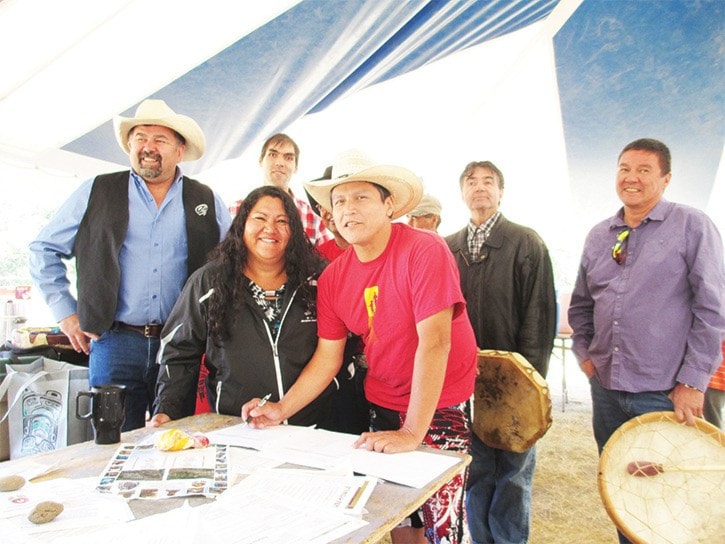The Tsilhqot’in First Nation and Interior Health Authority (IHA) signed a letter of understanding (LOU) on Aug. 21, at the Tsilhqot’in Nation Gathering, designed to deliver better health care services to Tsilhqot’in members both on and off reserve.
All six Tsilhqot’in chiefs, Bernie Mack (?Esdilagh), Roger William (Xeni Gwet’in), Percy Guichon (Tsi Deldel), Joe Alphonse (Tl’etinqox), Russell Myers Ross (Yuniset’in) and Francis Laceese (Tl’esqox), signed the agreement, along with IHA board member Rosanna McGregor.
For the past year an advisory group known as the Tsilhqot’in Health Hub, made up of the health directors and some elected leaders from each Tsilhqot’in community, worked to develop the letter of understanding with Interior Health. As a result of this signing, both parties agree to work together to improve health care service delivery and work together on a plan to deliver more culturally appropriate services.
First Nations in B.C. are in the process of transferring health services from Health Canada to First Nations Health Authorities. The transfer will occur on Oct. 1.
Connie Jasper, co-ordinator of the Tsilhqot’in Health Hub Committee, says on Oct. 1 IHA will be responsible for all First Nations people both on and off reserve.
“Within two years each health station in the First Nations communities will be band-owned,” she said
Besides Jasper, the Tsilhqot’in Health Hub Committee includes Bryan Yellowhorn, Teresa Johnny, Dora Grinder, Chief Percy Guichon, Patrick Lulua, Chief Roger William, Thelma Stump, Lorna Elkins and Pam Alphonse. IHA is represented by Brad Anderson and Danielle Wilson.
McGregor, an IHA board member for seven years, is IHA’s chair of Aboriginal Health. She said the LOU will provide local input into planning and programs and help provide better health outcomes for First Nations. She said two other LOUs have already been signed with other health authorities in the province.
“Basically it is just a document saying we will work together,” McGregor said. “The intent of the LOU is to ensure we’ve got fair services in seeking out care, and to fix health inequities in the system. We’ve got 20,000 employees with IHA, and a lot of good people have done a lot of good work.”
?Esdilagh Chief Bernie Mack, who sits on the provincial First Nations Health Committee, said he appreciates McGregor’s hard work, particularly with off-reserve people.
“We can improve health care by giving validity to our own medicines. We need to think what we can do as First Nations and what BC can do to put more Tsilhqot’in culture into health care.”
Mack said the Tsilhqot’in nation is part of a larger group of seven nations within Interior Health’s service area, which totals 54 bands. “Coming together is not easy, but working together is essential to get something done. Five fingers are stronger than one.”
Patrick Lulua, who has been health director for Xeni Gwet’in for over 20 years and ready to retire, said being a health director for your community is not easy. “It’s hard to keep everybody happy.”
Yuniset’in Chief Russell Myers Ross gave some examples of how Tsilhqot’in traditions can be incorporated into the health care system.
“We have traditional beliefs to keep the umbilical cord of newborn babies,” Myers Ross said. “We want space set aside in hospitals for prayers and smudging, and want doctors open to traditional medicines.”
Tl’etinqox Chief Joe Alphonse said not every society has all the answers.
“We need to blend our knowledge to get better results. We are proud of who we are and have a mandate from our communities to share our culture and experience. We have to get out there and educate the larger society.”
Xeni Gwet’in Chief Roger William said one of the goals of the LOU is to improve the efficiency of health care system through preventative health care practices.
“Our goal is to use the money within the health care system to make better decisions.”
Brad Anderson, the director of aboriginal health for IHA, stated that the ultimate goal of the LOU is partnerships and relationship-building.
Danielle Wilson, IHA’s representative for aboriginal health in the Williams Lake region, said the LOU is about working together.
“It’s about communication, collaboration and being at the table together. It’s an opportunity to identify the goals of this region.”
